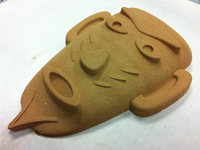 It was April 1st this week, the day when every blog post must be read with great suspicion. One very clever post from Freedom of Creation described an incredible experiment in 3D printing using powdered wood. The following day it was revealed to be a hoax – and a good one. Their very realistic post received many views and fooled a great many people. However…
It was April 1st this week, the day when every blog post must be read with great suspicion. One very clever post from Freedom of Creation described an incredible experiment in 3D printing using powdered wood. The following day it was revealed to be a hoax – and a good one. Their very realistic post received many views and fooled a great many people. However…Mark Ganter of the University of Washington contacted us to say:
… we CAN print in wood and it is one of the things that we will be announcing this coming week. It was truly an “Oh Sh*t” moment”.
And indeed they can, as shown in their post. As you can clearly see in the image above, it is actually possible to 3D print in wood!
They’re using a conventional approach: powdered material with a practical binder. It sounds like they’ve been investigating this technique for some time and had to experiment with a variety of woods and adhesives. As usual, they’ve come up with the right combination to permit practical 3D wood printing. Their formula:
Powdered Wood Flour — 4-5 parts by weight(use your favorite nut/wood flour @ 200-300 mesh)UF plastic resin glue — 1 part by weight
Wood flour is a commonly available substance, with prices as low as USD$1 per pound, depending on how much you’d care to carry home and the type of wood involved. Ganter’s team discovered, however, that wood flours are not always what they seem. In fact, many of these products were actually powdered nuts or tree bark. We recommend careful inspection of any wood flour product, particularly if you have nut allergies.
What does this mean? Let’s replay what we wrote in our gag FOC response:
We think this is a significant development, not only because wood is a far less expensive material that is typically available locally, but also because wood opens up more possibilities for 3D objects. There are plenty of applications both practical and artistic that will benefit from this new process. Wood just looks and feels different and will certainly be more appropriate for a wide range of new objects.
Since Open3DP has now conquered wood, we’re wondering what new materials they might be experimenting with in their labs.
Via Open3DP

